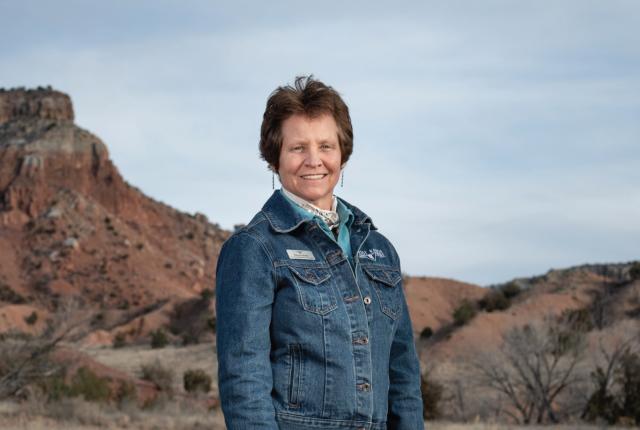GHOST RANCH HAS IT ALL—unbelievably red canyons looming over lavender-and-green hills, 205-million-year-old fossil remnants of an ancient tropical forest, and 9,400 years of human history, including outlaws, movie stars, teachers, hikers, yogis, and one legendary artist. For 14 years, Karen Butts’s job has been to help people make sense of it. She started as a volunteer, became a part-time employee, and now is the ranch’s tours and education manager. In that role, she crafts guided tours and courses to help visitors better understand the wonders arrayed around them and see that there’s more to Ghost Ranch than Georgia O’Keeffe’s house or the popular hike to Chimney Rock. She shows guests to off-limits portions of the 32-square-mile ranch and pulls out a film still or one of O’Keeffe’s more than 120 paintings made of that landscape. Enchantment ensues.
When I was a teenager, I was lucky enough to be able to go to a camp in Maine. I’d be there 30 days in a row, so we did the Allagash Wilderness Waterway, beyond the north end of the Appalachian Trail, a couple of times. As I did stuff like that, I was like, Okay, I want to keep doing this the rest of my life. So I just figured that if I worked in the field of outdoor education, I could find a way to work outside.
I lived in the Bay Area for a number of years, doing all kinds of different things. I worked for a company called Naturalists at Large, out of Southern California, and we were all just a bunch of vagabonds living out of the backs of our trucks. I got to work on the Lower Colorado River, Catalina Island, Sequoia National Park, Joshua Tree. I worked up at Yellowstone for a winter driving snow coaches, and in the summer I was a raft guide for a couple years. But it gets tiring, sleeping in the back of your vehicle, and it’s not conducive to stable relationships, either, and I was kind of ready for that.
I knew some people in the Abiquiú area, came to visit, and we bought land. A friend taught us how to lay adobe, so we ordered some adobe from Alcalde. We did it the way nobody would do it now—hardly anyone.
The way to get people to take care of the environment is to make them comfortable in it. My way to do that is by giving them information and short, guided experiences. People need to be able to relate to things, feel comfortable, and relax enough so they can take it in.
The great thing about Ghost Ranch is they’ve given me the freedom to do all this, which has really been remarkable—to grow and expand according to the interests of visitors.
People often come here wanting to know all about Georgia O’Keeffe and want to see her house. By the time they leave, they’re like, “Oh, there’s so much here. I’m going to come back and go hiking or spend the night with my family or take a class.”
We’ve got the Colorado Plateau, the Jemez Formation, and when you drop down the hill you enter the Río Grande rift zone, which is a tear in the earth that happened 30 million years ago. The White Place is down the hill, north of Abiquiú, and that’s another geologic formation, which is a pyroclastic flow from Questa that happened 22 million years ago. So there’s a lot going on. It’s very dynamic.
This is the edge of something. People come here and they are just like, “Wow, it’s so different.” It’s interesting: You can see it either scares people, honestly, or they just feel full of possibilities. So it’s pretty cool. It’s a transformational place in many ways.

SEE FOR YOURSELF
Take a tour of Georgia O’Keeffe’s landscapes, go for a hike, visit the museums, or find a workshop just for you at Ghost Ranch.


